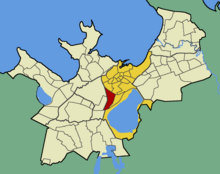Kitseküla

Kitseküla (in German "Ziegendorf") is a district ( Estonian asum ) of the Estonian capital Tallinn . It is located in the Kesklinn district ("inner city").
Description and history
Kitseküla has 3,368 inhabitants (as of May 1, 2010).
The memorial stone for Blasius Hochgrewe has stood here since the 16th century .
The district lies between the two important railway lines Tallinn- Paldiski (opened in 1870) and Tallinn- Viljandi (opened in 1900). Until 1971, the Tallinn-Väike station (historical German name Reval-Kleinbahnhof , historical Russian name Ревел-Главное) was in operation for narrow-gauge railways .
The city district emerged as a working class suburb at the turn of the 19th and 20th centuries. Most of the residential buildings were built from 1900 to 1913 and 1928 to 1939. At the end of the 1950s, the Soviet city planners also erected some buildings in the style of Stalinist classicism . After Estonian regained independence, modern office and commercial high-rise buildings have been built in Kitseküla since the 1990s.
Kitseküla is home to Tallinn's international football stadium, A. Le Coq Arena . It is also the home stadium of the Estonian first division club FC Flora Tallinn .
photos
A. Le Coq Arena football stadium
Web links
- (Tallinn-Väike) History of Kitseküla (Estonian)
Individual evidence
- ↑ Archived copy ( Memento of the original from May 17, 2011 in the Internet Archive ) Info: The archive link was inserted automatically and has not yet been checked. Please check the original and archive link according to the instructions and then remove this notice.
Coordinates: 59 ° 25 ' N , 24 ° 44' E





